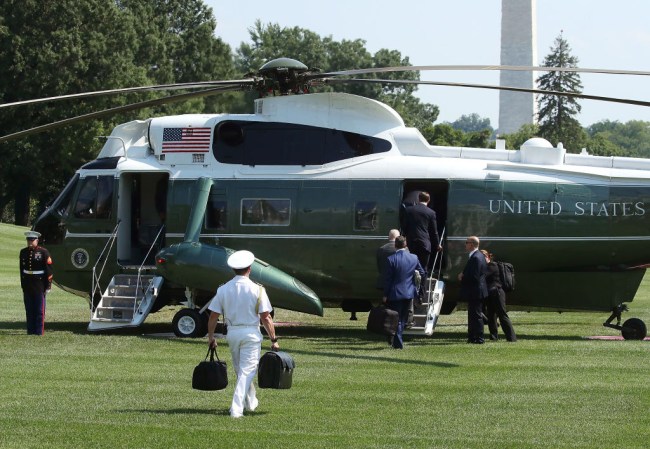
YouTube / LLNL
Supreme leader of North Korea Kim Jong-un told the citizens in his isolated country that “the United States can never fight a war against me and our state,” in a nationally televised New Year’s Eve event. “It should properly know that the whole territory of the U.S. is within the range of our nuclear strike and a nuclear button is always on the desk of my office, and this is just a reality, not a threat.” President Donald Trump reacted to that menacing statement by tweeting, “North Korean Leader Kim Jong Un just stated that the ‘Nuclear Button is on his desk at all times.’ Will someone from his depleted and food starved regime please inform him that I too have a Nuclear Button, but it is a much bigger & more powerful one than his, and my Button works!” This prompted many people to ask “How does the President launch nukes?” First off, there is no nuclear button.
The nuclear button has been a symbol of the immense responsibility that every leader of a nation equipped with world-ending nuclear weapons has as well as how fast our civilaztion could be annihilated. However, there is no actual nuclear button. Every country has their own process for launching nukes, but for the President of the United States, there are several steps that he or she must do to fire nuclear weapons.
The commander-in-chief has sole authority to use nuclear weapons, but military advisers will inform the President of the various options and alternatives, they may even attempt to change his mind. Depending on the situation, the consultation may last only 30 seconds if time is of the essense such as if the President is ordering a counterstrike in retaliation to enemy nukes headed to the United States. Land-based missiles launched from Russia or China can reach targets in the United States within 30 minutes, submarine-launched intercontinental ballistic missiles can hit the U.S. in 12 minutes.
After the briefing, the President would choose from the Major Attack Options from his list of choices listed in the “Black Book.” The Black Book contains the retaliatory options, classified nuclear site locations, safe spots for the President to be transported, a manila folder with pages giving a “description of procedures for the Emergency Alert System, and a three-by-five inch card with authentication codes” known as the “Gold Codes.” The Black Book is located in the “nuclear football,” which is a 45-pound briefcase that accompanies the President wherever he goes. The nuclear football is carried at all times by one of five military aides, representing each branch of the United States armed forces.

Getty Image / Mark Wilson / Staff
WASHINGTON, DC - AUGUST 04: A military aide carries the nuclear football as he departs with President Trump on Marine One from the White House on August 4, 2017 in Washington, DC. President Trump is traveling to Bedminster, N.J. for his summer break. (Photo by Mark Wilson/Getty Images)
The President has the last word, but there is a second person who must verify the orders for a nuclear attack. There is a complex system of communication protocols to ensure that the order to launch nukes is actually coming from the President and not an imposter or lower ranking official. The President contacts the National Military Command Center also known as the “War Room” at the Pentagon on a secure line, either from the “Situation Room” inside the White House or from the nuclear football.
The President is securely patched into the Pentagon and is in direct contact with the Secretary of Defense, who is the senior officer in the Pentagon’s War Room. The Secretary of Defense must formally authenticate that the orders to launch nukes are coming from the actual POTUS. “The officer reads a ‘challenge code,’ often two phonetic letters from the military alphabet, such as ‘Delta-Echo,'” Bruce G. Blair, a former Minuteman missile-launch officer and research scholar at Princeton University’s Program on Science and Global Security, told Bloomberg. “The president retrieves the ‘biscuit,’ a laminated card the president or military aide carries at all times, and finds the matching response to the challenge code: ‘Charlie-Zulu,’ for instance.” The Secretary of Defense can not veto the President’s decision to launch nukes, he or she can only authenticate that the order was given by the actual President.
If the codes are authenticated, the War Room deciminates an encoded and encrypted message, which is only about 150 characters long, to the according worldwide command center and then directly sent to launch crews. Within minutes after the President declares nuclear war, submarine and ICBM launch crews receive their orders. The launch crews then open safes which contain sealed-authentication system (SAS) codes. They then compare the SAS codes in the launch order with those in their safes. If they match, nuclear weapons are launched.
On a nuclear submarine, the captain, executive officer, and two others must authenticate the order to launch. The missiles take approximately 15 minutes to be armed and ready to launch. In underground missile silos, there are five launch crews consisting of two people that control a squadron of 50 nuclear missiles that are miles apart. The crews designate a launch time, and then must turn their keys simultaneously to verify that all five teams received the correct codes and all “voted” to launch nuclear missiles. From the time the President orders a nuclear strike, it takes about five minutes for land-based ICBM’s to be launched.
There is one way the President can lose their ability to order nuclear strikes. If Section 4 of the 25th Amendment to the Constitution is invoked, the President would be forbidden from launching nuclear weapons. The 25th Amendment allows the Vice President and a majority of the cabinet or a majority of Congress to declare the President disabled or unfit to execute the duties of the office.